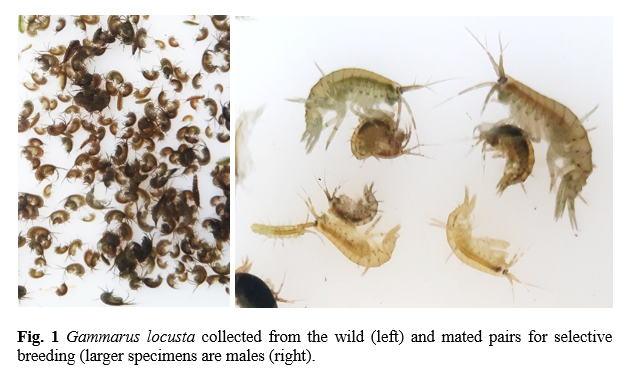"SEA BUGS" – MARINE GAMMARID AMPHIPODS AS A SOURCE OF N-3 LONG-CHAIN POLYUNSATURATED FATTY ACIDS
Introduction
M arine farmed fish are praised for their nutritional value for human consumption, but their n -3 long-chain (≥C20) polyunsaturated fatty acids content strongly depends on their diet. For decades , fishmeal and fish oil have been used to formulate aquafeeds , a practice that is increasingly questioned, as it supplies n -3 LC-PUFA through fish for human consumption but also depletes wild fish resources. To tackle the generalised shortage of n -3 LC-PUFA rich marine ingredients, the industry started targeting plant-based ingredients. However, these are richer in n-6 fatty acids and lack n-3 LC-PUFA. Th ese caveats negatively affect fish health, performance, and nutritional value.
The quest for the diversification of sources able to deliver suitable levels of n-3 LC-PUFA has focus ed on krill and single-cell organisms (e.g., microalgae and protists). However, most of such alternatives are still too costly for mainstream uses. Bio-engineered transgenic oilseed crops have also been put forward as an option , but their fatty acid profiles often feature an imbalanced n-3/n -6 ratio, and several countries still restrict the use of genetically modified organisms. Insects have sparked a growing interest in the industry , being considered as a promising ingredient for aquafeeds formulation , with emphasis on black soldier fly (Hermetia illucens ). However, insects only display interesting levels of n -3 LC-PUFA if these are supplied through their diet , as they bioaccumulate these biomolecules, rather than biosynthesizing them de novo.
Marine gammarid amphipods emerge as a promising source of n-3 LC-PUFA, despite remaining largely overlooked . These highly diverse group s of “sea bugs” , are in fact shrimp-like peracarid crustaceans (with a few mm size) that are found in multiple aquatic environments . Their trophic plasticity makes them promising candidates for circular bioeconomy approaches , aiming to add value to terrestrial food-processing by-products by upgrading them into a n -3 LC-PUFA rich biomass.
n-3 LC-PUFA profile of marine gammarids
The ability of marine gammarids to produce n -3 LC-PUFA has been reasoned from feeding experiments studying the impact of different diet s on the fatty acids of their body composition. While gammarids possess elongases that play a role in n -3 LC-PUFA biosynthesis, the full mechanism of eicosapentaenoic acid (EPA, 20:5n-3) and docosahexaenoic acid (DHA, 22:6n-3 ) synthesis is yet to be fully understood on these organisms, as they appear to lack desaturases ; these enzymes are needed for de novo synthesis of these fatty acids through known pathways. I t has been hypothesized that this ability to synthetize EPA and DHA may result from alternative mechanisms, such as contributions from gammarids’ microbiota. These “sea bugs” , namely Gammarus locusta (Figure 1), have been shown to be able to perform trophic upgrad e, as they can convert lower-value feeding substrates (e.g., seaweeds, land vegetables… ) into higher-value nutrients, which ultimately improves their nutritional value as a dietary ingredient/supplement . By using d iets from non-marine sources , namely agricultural by-products , to farm marine gammarid amphipods, one can support circular bio economy principles and enhance resource efficiency , while simultaneously reducing the needs on more traditional ingredients.
Conclusion
Marine gammarid amphipods can convert both lower-value marine and non-marine feeding substrates into high-value n-3 LC-PUFA through trophic upgrad e. With farmed amphipod gammarid offspring reaching sexual maturity at only six weeks post-hatching it may be possible to address nutritional programming and selective breeding practices , allowing to develop lineages that may even outperform wild conspecifics in terms of their n -3 LC-PUFA composition . Overall, this approach will strongly contribute to merg e green and blue food ecosystems, contributing towards a more sustainable aquaculture.
Acknowledgements
This study was performed under the scope of the project “BLUE BIOECONOMY PACT” (Project Nº. C644915664-00000026), co-funded by the Next Generation EU European Fund, under the incentive line “Agendas for Business Innovation” within Component 5—Capitalization and Business Innovation of the Portuguese Recovery and Resilience Plan (RRP), as well as under the scope of the project “PUFAPODS Merging blue and green food systems - Using marine gammarid amphipods supplied with plant food processing side streams to produce n-3 LC-PUFA” which is supported by FCT/MEC https://doi.org/10.54499/2022.01620.PTDC. We also thank the financial support to UID Centro de Estudos do Ambiente e Mar (CESAM) + LA/P/0094/2020 through national funds.
